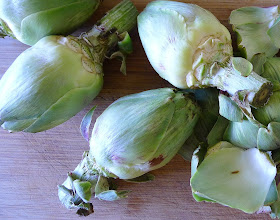I´ve got just the marinade for your weekend grilling. Adobo. Adobo marinade is usually used for fish or meat to preserve it a few days. But the strong flavors work well for a last minute rub. I used it with chunks of rape--that's Spanish for monkfish or angler fish--then threaded them on skewers with peppers, onions and cherry tomatoes. For two, we're not firing up the grill on the patio. The kebabs are so fast on a grill pan.
 |
| Monkfish kebabs on a bed of quick-cooking couscous with a side of first green beans from the garden. |
 |
| No sauce is needed. Adobo punches up the flavor and keeps fish moist. Lemon on the side for extra tang; a few toasted pine nuts scattered over all. |
 |
| Skewered fish cooks in under 5 minutes. |
Adobo Marinated Fish Kebabs
Brochetas de Rape Adobado
Any firm-fleshed fish works well. Try shark (cazón in Spanish), swordfish, tuna, mackerel, halibut or grouper.
Serves 4.
6-inch bamboo skewers
1 pound boneless monkfish
3 cloves garlic, minced
1 teaspoon sweet pimentón (paprika, not smoked)
¼ teaspoon smoked hot pimentón
1 teaspoon oregano
1 tablespoon finely chopped parsley
Pinch of cumin seeds
½ teaspoon salt
2 tablespoons olive oil + more for vegetables and grill pan
1 teaspoon Sherry vinegar
1 teaspoon water
Green bell pepper
Onion
Cherry tomatoes
Coarse salt
Lemon slices, to serve
Soak the skewers in water.
Cut the monkfish into 1 ¼ -inch cubes and place them in a bowl.
 |
| Marinade mix. |
In a small bowl, combine the garlic, two kinds of pimentón, oregano, parsley, cumin, salt, 2 tablespoons of oil, vinegar and water. Mix well and pour over the fish. Stir to coat all of the pieces of fish. Allow to stand at room temperature for 15 minutes (or cover and refrigerate for up to an hour).
Cut the pepper and onion into 1 ½-inch pieces. Cut the cherry tomatoes in half. Combine them in a bowl and sprinkle with a little oil. Mix to coat the vegetables.
 |
| Marinated fish skewered with onions, peppers, tomatoes, ready to grill. |
Drain the soaked skewers and wipe them dry. Thread one skewer with one cube of fish. Thread remaining skewers alternating with halves of tomato, cubes of fish, slices of pepper, and pieces of onion.
 |
| Grill kebabs on gas or charcoal barbecue, on a flat grill pan or in a cast iron skillet. |
Heat a flat grill pan, brush it lightly with oil and sprinkle with coarse salt. Lay the fish kebabs on the grill. Moderate the heat so they don’t scorch. Grill about 2 minutes on each side. Remove the skewer with one cube of fish and check it for doneness. The fish should be opaque in the center and flake easily.
Serve the kebabs hot or room temperature with lemon slices.
More versions of adobo:
More about monkfish here.















































